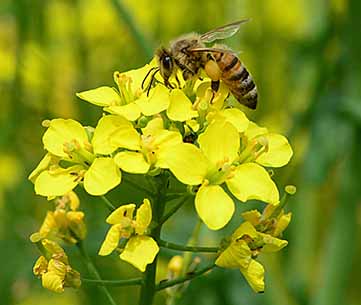THE use of agricultural chemicals can have the unintended consequence of destroying bees, robbing farmers of the valuable service they provide through pollination of crops.
Agriculture Victoria’s leading chemical standards officer, Alex Perera, said farmers and apiarists could gain significant benefits from working together and maintaining two-way communication to avoid bees becoming ‘collateral damage’ in spraying activities.
Ms Perera said entire colonies could be destroyed when inadequate care was taken by either party.
“With summer weed spraying about to begin, now is the ideal time for apiarists, growers and agricultural chemical applicators to talk to each other,” she said.
“With summer weed spraying about to begin, now is the ideal time for apiarists, growers and agricultural chemical applicators to talk to each other,” Ms Perera said.
“When communication breaks down, apiarists won’t know they are placing hives close to crop spraying activity and crop owners may spray without knowing the potential threat to nearby hives.
“Protecting bees and ensuring better pollination of crops is a win for both parties.
“Good communication and simple precautions minimise potential harmful impacts to bees.”
For agricultural chemical users, a number of tactics can reduce the risk to bees:
- Advise apiarists of your crop-spraying plans with as much notice as possible, preferably at least 48 hours, so they have time to remove hives.
- Use pesticides only when needed and according to the label directions.
- Read all sections of the label, including the “Protection of Livestock” statements (bees are livestock) and check if the product is toxic to bees.
- Ensure you comply with all DO NOT statements on the product label (e.g. ‘DO NOT spray any plants in flower while bees are foraging’).
- Use a pesticide formulation and application method that minimises potential harm to bees.
- Ensure pesticides do not drift from the target area.
- Ensure sprays do not contaminate water supplies.
Similarly, apiarists can use a range of tactics to protect their hives:
- Before placing hives in or near crops, work with landholders to establish a mutually acceptable chemical program.
- Leave your full, written contact details with the landholder on either a stand-alone sign at the site or on one or two hives to facilitate quick communication if an issue arises.
- Understand the chemical being used and avoid returning bees to a sprayed area before the risk to bees has dissipated.
- Establish a holding area at a safe distance from the crop, where hives may be temporarily placed while spraying occurs.
- Ensure bees have access to water that doesn’t contain pesticide residues.
- Inspect hives regularly to enable early detection and reporting of symptoms of bee poisoning.
For more information about managing bees and chemical use in harmony, visit
http://agriculture.vic.gov.au/agriculture/farm-management/chemical-use/agricultural-chemicaluse/sampling-bees-for-residue-testing or consult your agricultural chemical provider, or speak to local apiarists.
To report symptoms of bee poisoning, contact Agriculture Victoria on 136 186 and refer to the ‘Sampling bees for residue testing’ fact sheet.
Source: Ag Victoria




HAVE YOUR SAY